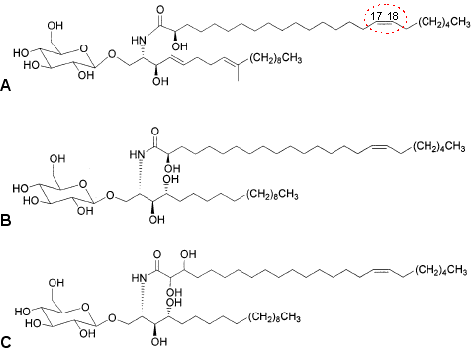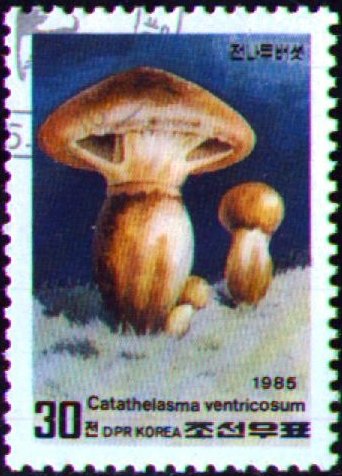The Imperial Cat, Catathelasma ventricosum (Peck) Singer.
Classification
Kingdom Fungi
Phylum Basidiomycota
Class Basidiomycetes
Order Agaricales
Family Tricholomataceae
Genus Catathelasma
Synonyms
Armillaria ventricosa (Peck) Peck
Biannularia ventricosa (Peck) Pomerl.
Lentinus ventricosus Peck
Common names
Imperial cat
Swollen-stalked cat
Mock matsutake
Momitake (Japanese)
Description
Cap: 7-20 cm broad, convex to broadly convex; dingy white to brownish or grayish; dry, smooth, and breaking up into patches with age.
Gills: decurrent, close to nearly distant, narrow to broad; whitish.
Stem: 5-15 x 2.5-8 cm, stout but narrowing to a point and deep in soil; whitish to yellowish brown; dry.
Veil: partial double veil leaving flaring double ring; top layer hairy, bottom layer membranous and persistent.
Flesh: very thick, hard; white.
Odor: fragrant celery or cucumber smell.
Taste: mildly unpleasant.
Spores: ellipsoid, smooth, amyloid, white or cream-yellow, 9-12 x 4-6 µm.
Spore print: white.
Habitat: scattered or in groups on ground under conifers, especially spruce. Frequent.
Distribution: Northern North America, southwestern mainland China.; season August-October.
This choice edible mushroom is mycorrhizal on the roots of spruce. Initially forming a hypogeous white ball, it emerges to reveal decurrent gills. The characteristic odor is due at least in part to trans-2-nonenal (Wood et al., 1994).

My name is Austin Collins.
I've dedicated my life to Mushrooms.
I believe Mushrooms are the best kept secret when it comes to health and well being.
For that reason, I would like to share a company with you that in my opinion makes the best mushroom products on the market.
The company is called Noomadic Herbals, my favorite supplement they make is called "Mushroom Total".
I take their products every day and they have helped me think better and have more energy. Give them a try.
-Austin
Bioactive compounds
Three new glycosphingolipids with a cis-Δ17-fatty acyl moiety, namely, catacerebrosides A-C (shown below), along with two known glycosphingolipids, cerebrosides B and D, six known ergostane-type sterols, and tyrosamine were isolated from the ethanolic extract of Catathelasma ventricosa (Zha and Yue, 2003).

Novel cerebrosides isolated from C. ventricosa. (a) catacerebroside A, or 1-O–β–D-glucopyranosyl-(2S,3R,4E,8E)-2-[(2‘R,17‘Z)-
2‘-hydroxy-17‘-tetracosenoylamino]-9-methyl- 4,8-octadecadiene-1,3-diol. The red circling highlights the unique cis-Δ17 double bond. (b) catacerebroside B, or 1-O–β–D-glucopyranosyl- (2S,3S,4R)- 2-[(2‘R,-17‘Z)-2‘-hydroxy- 17-tetracosenoylamino] octadecane-1,3,4-triol. (c) catacerebroside c, or 1-O–β–D-glucopyranosyl- (2S,3S,4R)-2-[(17‘Z), 2‘,3‘-dihydroxy- 17-tetracosenoylamino] octadecane-1,3,4-triol. The authors point out that this is the first example of a glycosphingolipid with a 2,3-dihyroxyl fatty acyl moiety. Figure modified from Zha and Yue, 2003.
No specific bioactivity has yet been ascribed to these novel glycosphingolipids. In general, cerebrosides are important components of muscle and nerve cell membranes. Some interesting biological effects have been demonstrated by this class of molecules, including immune system stimulation and anticancer properties (source: Kolter, T. 2004. Glycosphingolipids. In: Bioactive Lipids. pp. 169-196 (edited by A. Nicolaou and G. Kokotos, The Oily Press, Bridgwater)).
Medicinal properties
Antitumor effects
Polysaccharides extracted from the mycelial culture of C. ventricosum and administered intraperitoneally into white mice at a dosage of 300 mg/kg inhibited the growth of both Sarcoma 180 and Ehrlich solid cancers by 80% (Ohtsuka et al., 1973).
Links
- Mushrom Expert
- there are a number of pictures to see at Mycoquebec.org
- check out a picture of some spores here.
References
Ohtsuka S, Ueno S, Yoshikumi C, Hirose F, Ohmura Y, Wada T, Fujii T, Takahashi E.
Polysaccharides having an anticarcinogenic effect and a method of producing them from species of Basidiomycetes.
UK Patent 1331513, 26 September 1973.
Wood WF, Brandes ML, Watson RL, Jones RL, Largent DL.
Trans-2-nonenal, the cucumber odor of mushrooms.
Mycologia. 1994 86(4):561-3.
Zhan ZJ, Yue JM.
New glycosphingolipids from the fungus Catathelasma ventricosa.
J Nat Prod. 2003 66(7):1013-6.



